Energy - Natural Gas
Society is hungry and in need of resources. Once, we couldn't go a dozen feet without finding gold or coal or any direction. Now, we need to travel hundreds, or even thousands of miles, to drill into the Earth. In our search for fuel, we reach out to farther and more hazardous areas to feed our needs.
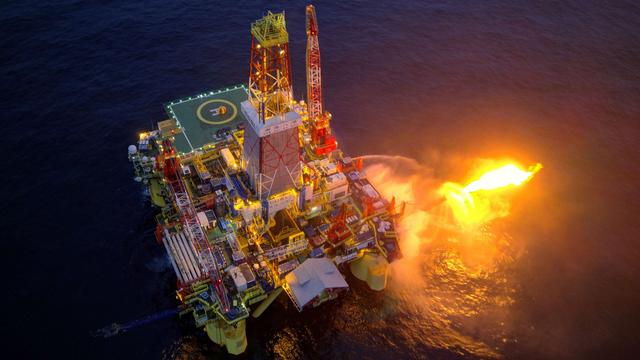
China’s Nan Hai Ba Hao platform in the Russian Arctic
Prologue
Ancient Greece

Image by Javier Rodriguez from Pixabay
Greek society established the Oracle at Delphi around 1400 B.C. (Ancient History). The oracle served farmers and kings by prophesizing their fate. Understand their teachings, and people thrive. Rush to judgment without carefully considering its meaning and, like King of the Lydians, your faith, as well as your kingdom, will fall (Ancient History).
Where did these powers of sight originate? Did the god Apollo indeed grant foresight to the Greek people? Perhaps there is an alternative source to the power of old we seem to have forgotten.
Plutarch, a priest at the temple of Apollo, attributes the Oracle's visions to vapors emanating from the group (National Geographic). In modern times, we know that vapor to be natural gas.
Introduction

Image by Robert Fotograf from Pixabay
Welcome, fellow Steemians, to our ninth installment of Energy Series Phase I - Commercial Power Production. During our series, we have discussed the various ways humanity produces electricity. We also touched on its impacts upon the Earth and its multitude of societies. Phase 1 focuses on commercial electricity generation. We discuss methods to produce power on a large scale. Billions of people receive lighting and electricity for their activities through the means we covered.
In this post, we will discuss the production of electricity through the use of natural gas. Additionally, we will cover the effect of this process upon the environment, and much more! We did not address the topic of natural gas energy in our first installment (Energy - Overview).
In our Energy series, we discussed how various forms of power production ultimately produce electricity. Coal, nuclear, concentrating solar, hydroelectric, wind, geothermal, biomass power plants produce electricity similarly albeit with different sources of fuel. Natural gas is not too different except that here it is the source fuel used to generate electricity.
What's Cooking Redfish Contest
I am thankful for being a part of the Steem and Steemit community. The grand folks at the Steem Terminal discord have me categorized as a redfish for good reason as I've only been active for close to two months now. The Steem universe is vast and I'm still learning the ways of crypto.
@sgt-dan has taken it upon himself to create this contest am I'm happy to submit my article for review. Thank you very much, friend. We can all due with some good exposure in the community.
My favorite topic, by far, is STEM. I love that being part of this community allows me to write, and receive feedback, on these topics. I don't know that I'll ever write outside of this area, but if I do, I know I'll get honest and professional feedback from those around.
And now to continue with our final article in this phase of the Energy series!
What is Natural Gas?

(The Energy Co-Op)
Natural gas is a fossil fuel. Similar to coal and oil, natural gas derives from the decay of plants and organisms from long ago. It is colorless, odorless, and highly flammable. Our society uses it for cooking, heating, as fuel for vehicles, or even as a component in plastics (Britannica). Heck, we can also use gas for laundry appliances (Digital Trends).
Brief Origin of Natural Gas
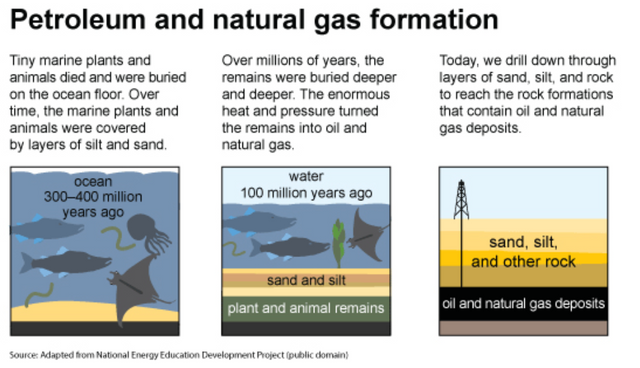
Energy Information Administration
Fossil fuels like natural gas formed over hundreds of millions of years. The death of plants and creatures over time, settled into the water and sedimentary layers. Pressure upon these plants and organisms forced them, over time, to forms into fuels like coal, oil, and gas. Today, we search the horizon for sources of these fuels for extraction (Energy Information Administration).
Natural Gas Processing
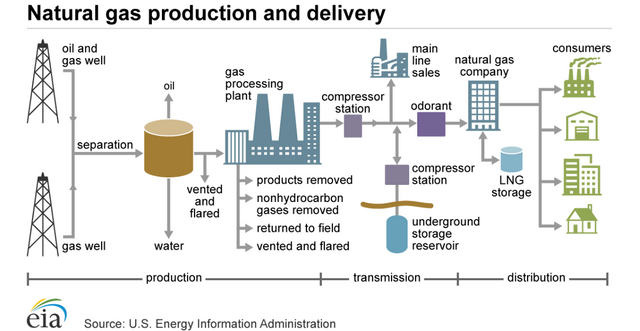 Energy Information Administration
Energy Information AdministrationNatural gas travels through many different stages before reaching your oven or the local power station. The main steps of this process are extraction, refinement, and distribution.
Extraction
Once we find it, we extract it. The profit potential of natural gas is so great that companies will scour virtually any location to harvest it. Once located, one of the ways we extract natural gas and oil is through a process called fracking.
In a nutshell, fracking is a process where we inject high-pressure water, sand, and chemicals into rock and sediment. The process allows a company to withdraw the gas in a controlled fashion to the surface (Environmental Health Center). The content creator Kurzsegagt does a fantastic job demonstrating the process, as well as, present the controversy involved with the process (Kurzgesagt - YouTube).
Refinement
Once we draw the gas from its well or separated from the oil, we process the gas to remove any non-desireable components (Energy Information Administration). These components are released from the natural gas and sent for treatment before use by the consumer. Processing plants add one of the more recognizable components to gas before distribution, namely the smell of rotting flesh. Natural gas is odorless, so adding the scent is mandatory if we ever want to recognize a gas leak.
Distribution
After processing, natural gas is ready for distribution. The industry distributes natural gas via underground piping that could stretch for thousands of miles to the end consumer (Natural Gas Org). The National Pipeline Mapping System provides layouts for gas piping across the United States. It is available for public use and will show you piping by state and county. General information is limited as the gas infrastructure is probably a national asset.
Natural Gas Power Generation
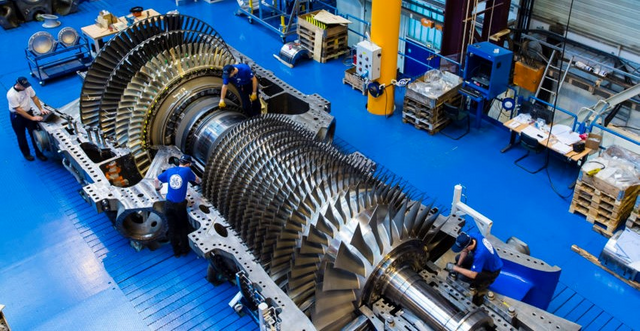
Gas Turbine Example - Power Magazine
In this segment of the Energy series, we'll discuss the use of natural gas in the combined cycle gas power plant. It is the most efficient means of generating electricity with natural gas as the fuel source. Power plants utilizing this type of technology have an efficiency rating upwards of 60% (NaturalGas.Org).
Combined Cycle Power Plants
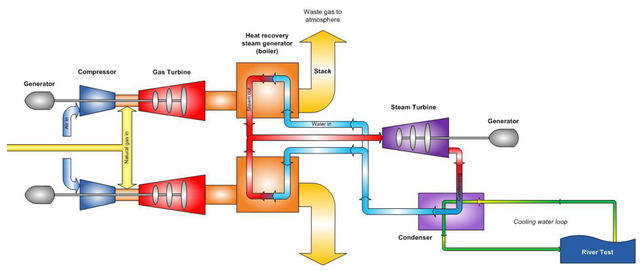
Marchwood Power
Using the above diagram as a guide, we see the system feeding in natural gas ("natural gas in"). The system feeds air into a compressor raising its pressure and temperature. The air and gas are combined and further heated before reaching the gas turbine. The combined high-pressure high-temperature gas-air mixture spins the turbine, which spins a generator. The generator creates electricity as it turns. The power generated is fed to a distribution system that ultimately provides power to the consumer.
Usually, the above description is where the story ends. However, in a combined-cycle power plant, the goal is to recover as much waste heat as possible and reuse it to continue generating power. In this case, any exhaust gases from the gas turbine flow into a heat recovery steam generator (S.G.). The S.G. collects the waste gases and uses its heat to convert water into steam that feeds into a steam turbine. Once again, a spinning steam turbine also rotates a generator that creates electricity.
Take a look at a video summary describing the use of natural gas in our power generation cycle.
GE Combined Cycle Video Summary
Power Demographics
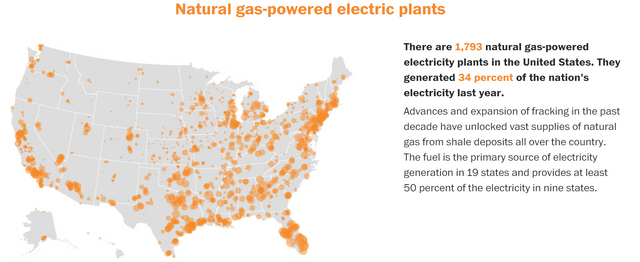
Washington Post - Based Upon 2016 data
The Washington Post provides a fantastic article on the types of electricity generation within the United States. It charts types of power production, as well as generating capacity.
Fossil Fuels
Use of fossil fuels, according to the Energy Information Administration in 2018, produces over 60% of the electricity used by the United States. Natural gas provides about 35% of this nation's energy, while coal now only produces 28%. The use of natural gas surpasses that of coal.
Environmental Impacts
Greenhouse Gas Emissions
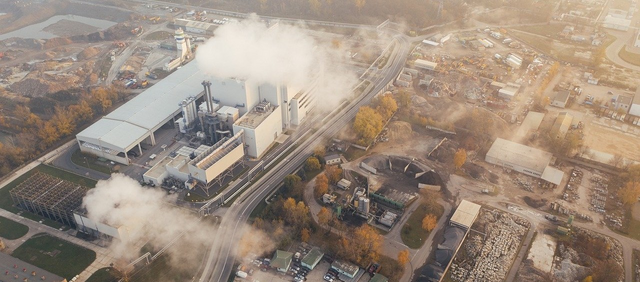
Image by marcinjozwiak from Pixabay
Extraction
Extracting gas from single-gas or oil-gas wells leads to the release of carbon dioxide and methane. Methane is a much more significant greenhouse gas as it is at least 30 times stronger, in some scenarios, than carbon dioxide at heating up the atmosphere (Union of Concerned Scientists).
Consumer Uses
Using natural gas is significantly cleaner than using coal. It is also much cheaper to use. Burning natural gas still releases components like nitrogen oxides, but at levels significantly lower than coal. You also don't have the coal ash generated that coal plants don't know how to handle ultimately.
Land and Water Contamination
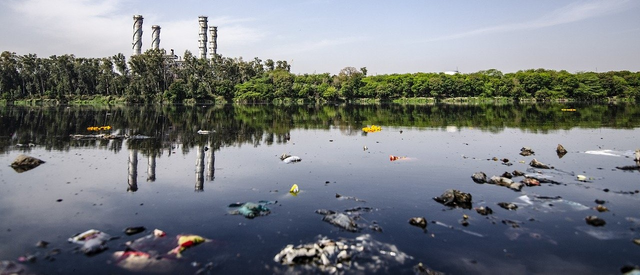
Image by Yogendra Singh from Pixabay
The most significant environmental problems with natural gas have to do with its extraction from the ground. The process of extraction is not gentle with the Earth. It involves hazardous chemicals, tons of water, and you are injecting this stuff into the ground to force the gas or oil-gas mixture to the surface.
In 2015, the New York Times reported on the detection of drilling chemicals within several Pennsylvania homes. The extraction processes are not fool-proof, and the industry, unfortunately, appears to have no accountability regarding the failure of their operations. While the sector states that drilling holes are significantly below underground water reservoirs, the New York Times reports that the fault in these cases may have been due to either faulty drilling wells or wells that became damaged during the process.
Health Effects & the EPA

Image by agnesliinnea from Pixabay
The Environmental Protection Agency once stated in a 2004-report that hydraulic fracking posed little to no risk of contaminating underground drinking water supplies (EPA 816-R-04-003). It's about a 400-page read. Still, its executive summary is quite surprising given the level of detail in their report. However, fast forward twelve years and their 2016-report now states that fracking poses a significant risk to these water supplies. It's amazing because I read through the reports. The 2016-report is more visually appealing, but it just seems as though they're restating a lot of the original information regarding the fracking process. I have no idea what the original authors thought when they wrote: "little to no risk."
Frackers inject carcinogens and neurotoxic chemicals into the ground during fracking. We already presented a New York Times report in this blog about drilling chemicals found in some Pennsylvania homes, but that's just scratching the surface.
A Yale News article reported that Yale researchers investigated the chemicals used in fracking. It is alarming. Among the hundreds of chemicals they identified, they found those that cause developmental and reproductive problems like arsenic, benzene, cadmium, lead, formaldehyde, chlorine, and mercury.
Ingesting any of these chemicals, in sufficient quantity, will lead to adverse health effects over time. The problem, unfortunately, is that no government agency will listen until the issues are epic and unable to be swept under a rug.
Natural Gas Advantages
 Image by Niek Verlaan from Pixabay
Image by Niek Verlaan from PixabayEnvironmentally Friendlier
If you can completely exclude the gas extraction process, then yes, the use of natural gas as a fuel during the power production process far surpasses that of coal. Both the industry, environmental groups, and the public recognize this fact. It won't generate the waste coal produces, and it costs significantly less than the use of fuel to create electricity and handle its wastes.
Minimizes Oil Dependence
Using natural gas does reduce the dependence on oil. Given our gas infrastructure, we can put natural gas in as many places that we can put oil.
Natural Gas Disadvantages

Image by Oberholster Venita from Pixabay
Highly Combustible

Image by Pete Linforth from Pixabay
The state of Connecticut's Department of Energy and Environmental Protection states that concentrations of natural gas less than 5% or greater than 15% does not pose a combustion risk. What this means is that if, for instance, the concentration of natural gas in an area is 4%, it won't explode or light on fire. The operative words here are "in an area." The risk depends on the size of the area that natural gas occupies.
In past articles in our Energy series, we wrote about how, when we generate electricity, we need to raise the voltage before sending power across transmission lines. We need to increase the voltage to compensate for losses of power while en route to the consumer.
Similarly, we need to raise the pressure of natural gas to get it ultimately to the consumer. Sometimes these systems fail. Pressure variations within the piping or failure to adequately inspect piping have been culprits. Hopefully, it is just equipment that becomes damaged. In other instances, portions of the systems fail near residential areas. These failures lead to explosions within areas like San Bruno, California and three towns in northern Massechusetts. The costs of these failures were too high as people and property exploded in flames.
Non-renewable source
It's true that, as a fossil fuel, natural gas is a non-renewable source for power production. Given what I've written, however, there is A LOT of natural gas in stores within the United States. Our consumption of this fuel is also amazing.
The Energy Information Administration estimates that the United States maintains an ever-increasing reserve of natural gas within its borders. The 2018 size of our natural gas reserves were approximately 550 trillion cubic feet. The amount of dry natural gas alone will last the U.S. an estimated 92 years (Energy Information Administration).
So, while we've written "non-renewable source" as a negative, it's only a negative in the long-term.
Plentiful and Cheap

Image by Brett Hondow from Pixabay
"Plentiful and Cheap" was once listed as an advantage during the development of this article. After reviewing the research material for this blog, I find that it is negative. The overall availability of natural gas, as well as the low cost of its "production," leads companies to seek out the resource in unfriendly environmental manners. Knowing that fracking can produce volumes of natural gas at a low price doesn't mean its something we should do on a large scale.
Natural gas is everywhere. Companies revel in the profits they see during this decades-long "Gas Rush." The government is woefully inadequate to handle concerns related to gas production in real-time. We've already seen that it took 12 years to reverse their position on fracking alone. Twelve years and billions of carcinogenic chemicals injected into the ground is not an adequate turn-around time to realize you were initially wrong.
Technology Summary
We have plenty of immediately available natural gas to cover the needs of the United States for several decades. However, this figure does not include the 500 or so trillions of cubic feet of natural gas available for extraction. Natural, like coal, isn't going anywhere due to its availability and cost. Therein lies a problem.
Natural gas is significantly cleaner than coal, and technologies exist and are used, which make this fuel even friendlier and more efficient. It's abundant, and its use costs significantly less to the consumer.
How we extract the fuel is controversial. You have thousands of companies injecting hundreds of toxic chemicals into thousands of wells to extract billions of cubic feet of gas. You can not tell me that there is no risk to the public, given the false urgency that exists to remove this fuel. Given what I've learned about fracking in this article, I'm more inclined to accept the devil you know in coal as opposed to being favorable to gas.
There has to be a better way to protect the environment than by trusting companies who aren't transparent about what they inject into the Earth.
In Closing

Image by Gerd Altmann from Pixabay
Thanks again, fellow Steemians, for following on with this series. Phase I of the Energy Series is complete. It's been a great ride, and I've appreciated all the reviews and votes from the Steem and STEM Communities.
Each topic presented poses different challenges during research. It is essential to cite all available references for this work to ensure that all readers can validate the information presented as they desire. The goal, ultimately, is the dissemination of accurate and thoughtful information. Unfortunately, some topics are more difficult to research than others.
Where do we go from here?

Image by Free-Photos from Pixabay
Phase I of the Energy Series dealt with commercial power production. We covered the generation of electricity that powers countries and societies on a large scale.
Phase II of the Energy Series deals with the experimental. It covers any form of power production that supplies electricity, but it isn't available for commercial wide-spread use at this time. Types of energy production include fusion, thorium-nuclear power, or any new application or variation of existing technologies.
Phase III of the Energy Series deals with the abstract forms of power production.
Honestly, there's no shortage of topics. One article in the works is part of a new series called Synergy and will deal with the transmission of electrical power. It will combine the means of commercial energy production discussed in the Energy series and discuss our means of transmitting power across Earth.
Another article in the works is in the Environmental Impact series called "Black Gold". Stay tuned for more!
Your thoughts?

Image by Free-Photos from Pixabay
What was your favorite article of this series? Is there anything else you'd like to see covered? Share your thoughts by entering your comments below!
Related Posts
| Coal | Nuclear | Solar | |
 |  |  |  |
| Hydroelectric | Wind | Geothermal | Biomass |
 |  |  |  |
 Image by
Image by
Fracking is truly one of the great crimes against Mother Earth, and against our collective future!
I had to smile at your very westernized explanation of gas distribution and how it reaches the end user. The vast majority of the world which uses natural gas doesn't have piping or infrastructure, but uses refillable bottles. Here in Thailand we use a gas bottle for our 2 burner cooker (think camping stove) - it's delivered by an old uncle on a motorcycle sidecar. :)
Leading the curation trail for both @ecotrain & @eco-alex.
Together We’re Making This World A Better Place.
Click Here To Join the manually curated trail "@artemislives" to support quality eco-green content.
@artemislives
Westernized indeed! This article was the longest I’ve written yet on Steem. Jeez I feel like I could write a book about what I’ve learned.
I had to focus on the more industrialized areas and the United States was easiest for me. I’m accustomed to the politics and very familiar with energy production here.
I imagine that in communities like yours there’s a lot more respect for resources than here.
More importantly, the larger the society the greater the impact. Companies appear to be fracking without impunity or oversight. I want to give a scope for how massive some of these project are.
My next article steers away from power production and just focuses on environmental impacts. I’ll be able to show how other countries are affected by black gold dominated by US, Middle East, and Asia.
Congratulations @scholaris! You have completed the following achievement on the Steem blockchain and have been rewarded with new badge(s) :
You can view your badges on your Steem Board and compare to others on the Steem Ranking
If you no longer want to receive notifications, reply to this comment with the word
STOPThis post has been voted on by the SteemSTEM curation team and voting trail. It is elligible for support from @curie and @minnowbooster.
If you appreciate the work we are doing, then consider supporting our witness @stem.witness. Additional witness support to the curie witness would be appreciated as well.
For additional information please join us on the SteemSTEM discord and to get to know the rest of the community!
Thanks for having included @steemstem in the list of beneficiaries of this post. This granted you a stronger support from SteemSTEM. Note that using the steemstem.io app could have yielded an even more important support.
really nice post :)
Thank you very much @btcfreeforall001
@tipu curate
Upvoted 👌 (Mana: 20/30 - need recharge?)
@girolamomarotta
Thank you very much...again! I appreciate the support.
Super
Excellent